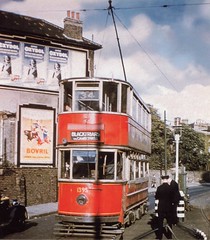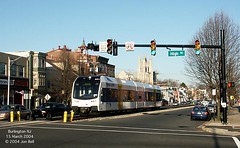Rail and buses sure, but let's be real...
Greater Greater Washington reports on a Coalition for Smart Growth session on bus "rapid" transit, in "What does a highway guy think about priority bus corridors?," which he summarizes as:
WMATA believes that the future of Greater Washington's transportation rests on priority bus corridors throughout the region, like the MetroExtra (#79) bus from Silver Spring to downtown DC. With Metrorail running out of capacity by 2030 and serious core expansion costing billions, Metro sees rapid buses as the best chance for a real capacity boost.
I don't know why we do this. How can anyone think that buses can be a significant method for complementing trains on the same routes when it takes about 7-10 60 foot long buses to equal one 6 car subway train? That's a lot of buses. And to move speedily it requires a separated guideway.
If you don't already have a grid-based road system, you're screwed. Unless you don't drive during peak periods, then it isn't so bad.
I do think though that we need to think about long vs. short trips and plan transit accordingly. Right now, Rockville Pike is more suburban and the strip served by the red line still is very much car dependent. Likely this can change over time (it's in planning stages, see "Readying Rockville Pike for Renewal" from the Post) and become more fine grained and "walkable" along the lines of Wilson Blvd. in Arlington. That either means walking, more local bus service, or streetcars. The red line, with the station spacing the way it is on Rockville Pike, has a hard time providing both local (say trips within DC's core, or along Wilson Blvd.) and longer distance (Rockville to DC e.g.) trips.
Too bad that the system was designed in a way that it can't really be expanded upwards, with doublestacked trains.
A couple places in the world have double deck trolley cars.

Double deck streetcar in London, 1949.
But the cost of rebuilding the red line tunnels and the fact that they would be out of commission while doing so, for doublestack cars, means it will never happen with the WMATA red line...

AFP photo of the WMATA subway tunnel by Karen Bleier.
What's required is a fully articulated vision for transit which likely includes railroad + subway + light rail + streetcar + various levels of bus service.
Speaking of light rail, which is different--faster and usually greater capacity than streetcar--this photo from Jon Bell's transit pages of the light rail system in the Camden, NJ region makes me think about light rail for the H Street streetcar line. Maybe higher capacity light rail there is the interim "separated blue line"? The H Street line, from Minnesota Avenue (and perhaps farther east) to Georgetown and even across the bridge to Rosslyn, might be a higher capacity line with a greater proportion of long trips.
Also, you can run streetcars and light rail on the same system if you provide for it. This could be done to provide more frequent service from Union Station to the H Street commercial district. See "Adding cultural heritage dimensions and expanded service capabilities within commercial districts to DC Streetcar planning."

Burlington, NJ on the Camden-Trenton River Line Light Rail.
Labels: transportation demand management, transportation planning



0 Comments:
Post a Comment
<< Home